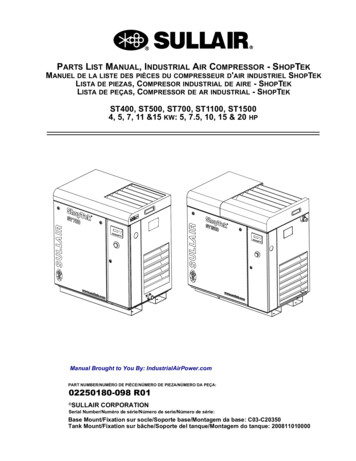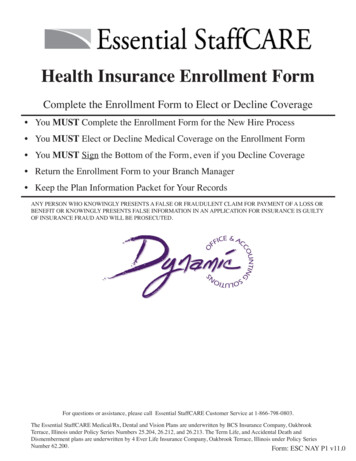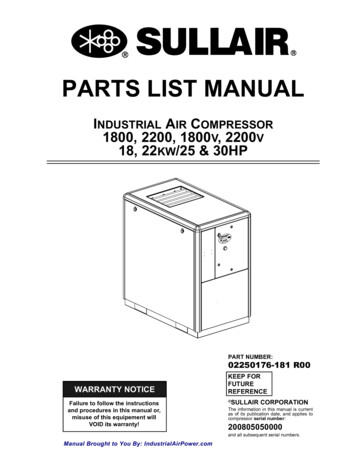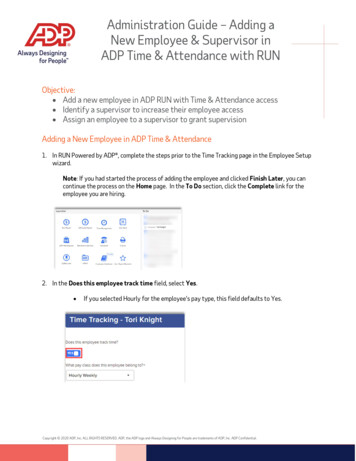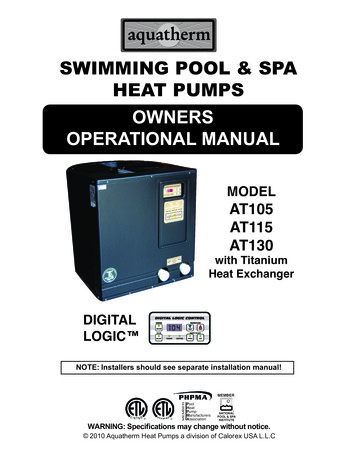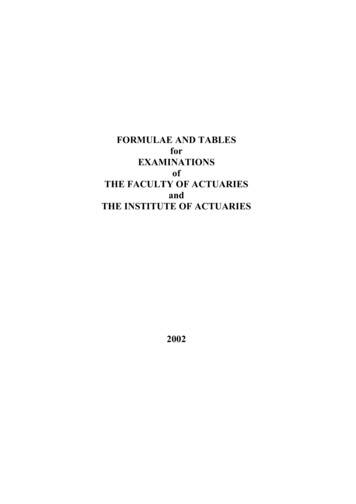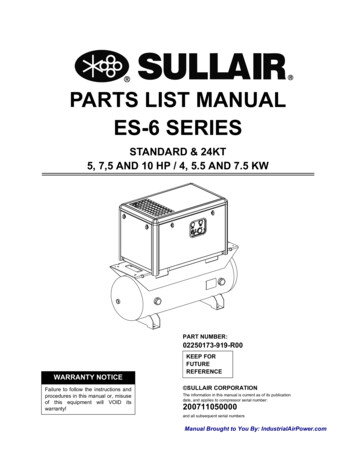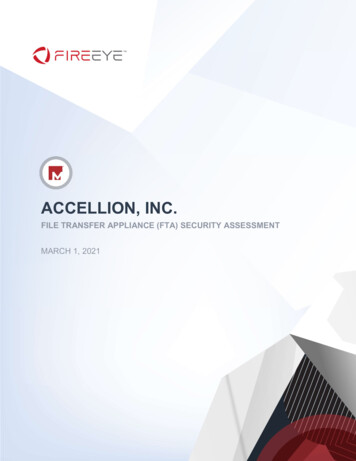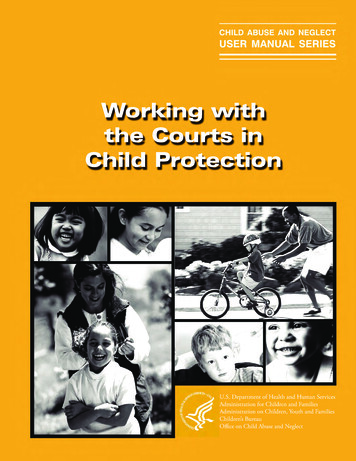
Transcription
CHILD ABUSE AND NEGLECTUSER MANUAL SERIESW orking withthe CourtsinChild OfOficeonChildAbuseandNeglect
Working with the Courtsin Child ProtectionThe Honorable William G. Jones2006U.S. Department of Health and Human ServicesAdministration for Children and FamiliesAdministration on Children, Youth and FamiliesChildrenÊs BureauOffice on Child Abuse and Neglect
Table of ContentsPREFACE .1ACKNOWLEDGMENTS . 31.PURPOSE AND OVERVIEW. 52.THE COURT SYSTEM AND CHILD PROTECTION. 7Jurisdiction .7Juvenile Court.7Specialized Courts .8Powers of the Court .10The Rights of Parents and Children in Child Maltreatment Cases .133.THE INTERPLAY BETWEEN CHILD MALTREATMENT LEGISLATION ANDCASEWORKER PRACTICE. 17The Child Abuse Prevention and Treatment Act .17The Individuals with Disabilities Education Act .19The Indian Child Welfare Act .19The Adoption Assistance and Child Welfare Act .19The Adoption and Safe Families Act.20The Interstate Compact on the Placement of Children.214.THE JUVENILE COURT PROCESS . 23The Petition for Removal .23The Initial Hearing .26Pretrial Conferences .28Discovery .29The Adjudication Hearing.29The Disposition Hearing .30Review Hearings .32Working with the Courts in Child Protectioni
The Permanency Hearing .33Termination of Parental Rights .34Adoptions .37Appeals .395.THE CRIMINAL COURT PROCESS . 41Arrest, Bail, and Other Conditions of Release .41Preliminary Hearings .42Discovery.42Plea Bargaining .42Trial .426.DOMESTIC RELATIONS CASES AND OTHER COURT PROCEEDINGS . 45Custody and Divorce Hearings .45Domestic Violence Hearings .48Mental Health Hearings.49Confidentiality of Court Records .51Suits Against Child Protective Services Caseworkers and Agencies .51Class Actions Against Agencies.517.GOING TO COURT . 53The Rules of Evidence.53Expert Testimony.55Court Reports .55Testifying .55Ex Parte Communications.57Children’s Testimony.57Judges’ Expectations of Child Protective Services Caseworkers .618.WORKING WITH THE COURTS. 65Understanding Judges .65What Caseworkers Can Do To Effect Change in the Court .669.COURT IMPROVEMENT AND BEST PRACTICES. 71Child and Family Services Reviews and the Courts .71Best Practices .74Judicial Leadership.76Conclusion .78ENDNOTES . 79iiTable of Contents
APPENDICES:APPENDIX A GLOSSARY OF TERMS. 83APPENDIX B RESOURCE LISTINGS OF SELECTED NATIONAL ORGANIZATIONSCONCERNED WITH CHILD MALTREATMENT. 91APPENDIX C STATE TELEPHONE NUMBERS FOR REPORTING CHILD ABUSE. 99APPENDIX D GUIDELINES FOR CHILD PROTECTIVE SERVICES CASEWORKERSFOR PERMANENCY AND REVIEW HEARINGS. 101APPENDIX E LEGAL AND JUDICIAL ISSUES SUGGESTED BY THE CHILD ANDFAMILY SERVICES REVIEW PERFORMANCE INDICATORS. 111Working with the Courts in Child Protectioniii
PrefaceEach day, the safety and well-being of childrenacross the Nation are threatened by childabuse and neglect. Intervening effectively in thelives of these children and their families is not thesole responsibility of a single agency or professionalgroup, but a shared community concern. TheChild Abuse and Neglect User Manual Series hasprovided guidance on child protection to hundredsof thousands of multidisciplinary professionals andconcerned community members since the late 1970s.The User Manual Series provides a foundation forunderstanding child maltreatment and the rolesand responsibilities of various practitioners in itsprevention, identification, investigation, assessment,and treatment. Through the years, the manuals haveserved as valuable resources for building knowledge,promoting effective practices, and enhancingcommunity collaboration.Since the last update of the User Manual Series inthe early 1990s, a number of changes have occurredthat dramatically affect each community’s response tochild maltreatment. The changing landscape reflectsincreased recognition of the complexity of issues facingparents and their children, new legislation, practiceinnovations, court improvements, and system reformefforts. Significant advances in research have helpedshape new directions for interventions, while ongoingevaluations show “what works.”Working with the Courts in Child ProtectionThe Office on Child Abuse and Neglect within theChildren’s Bureau of the Administration for Childrenand Families, U.S. Department of Health andHuman Services, has developed this third edition ofthe User Manual Series to reflect increased knowledgeand the evolving state of practice. The updated andnew manuals are comprehensive in scope while alsosuccinct in presentation and easy to follow, andthey address trends and concerns relevant to today’sprofessional.This manual, Working with the Courts in ChildProtection, provides a basis for understanding courtprocesses most relevant to child abuse and neglectcases. The manual offers guidance and practical tipsprimarily for child protective services caseworkers. Italso may be useful to other nonlegal professionals,such as those working in law enforcement, healthcare, mental health, and child advocacy, who wish togain a better understanding of court processes.This manual builds on information presented in otherpublications in the User Manual Series, particularly ACoordinated Response to Child Abuse and Neglect: AFoundation for Practice and Child Protective Services:A Guide for Caseworkers. Readers are encouraged torefer to other manuals relevant to their professionsand interests.1
User Manual SeriesThis manual—along with the entire Child Abuse and Neglect User Manual Series—is available from ChildWelfare Information Gateway. For a full list of available manuals and ordering information, contact:Child Welfare Information Gateway1250 Maryland Avenue, SWEighth FloorWashington, DC 20024Phone: (800) FYI-3366 or (703) 385-7565Fax: (703) 385-3206E-mail: info@childwelfare.govThe manuals also are available online at reface
ACKNOWLEDGMENTSPRIMARY AUTHORThe Honorable William G. Jones is a retired juvenileand family court judge who served for 25 years for theMecklenburg County District Court hearing childabuse and neglect, termination of parental rights,and other family court cases. He has been a long time member of the National Council of Juvenile andFamily Court Judges and its Permanency Planningand Family Violence Departments. In Charlotte,North Carolina, Judge Jones was instrumental in theestablishment of the Guardian ad Litem Program,the Children’s Law Center, a Supervised Exchangeand Visitation Center, and the Family Court. Hecontinues to sit as an emergency judge in NorthCarolina, serves on two court-appointed panelscharged with monitoring compliance by child welfareagencies with U.S. District Court injunctions, and actsas a consultant to various communities and programsregarding children and families in the courts.human service agencies regarding the intersection ofdomestic violence and child abuse and neglect.ACKNOWLEDGMENT OF PRIOR EDITIONThis manual is an update of the 1992 publicationWorking with the Courts in Child Protection by JaneNusbaum Feller with Howard A. Davidson, MarkHardin, and Robert M. Horowitz. The first edition ofthe manual was published in 1980 as Child Protection:The Role of the Courts by Hortense R. Landau, MarshaK. Salus, and Thelma Stiffarm, with Nora Lee Kalb.The prior work informed and contributed to thecontent of this publication.REVIEWERSHoward Davidson, American Bar AssociationMark Hardin, American Bar AssociationCONTRIBUTORBeverly Heydon, Howard County, Maryland, Officeof LawH. Lien Bragg, M.S.W., is a former consultant withCaliber, an ICF International Company. She has overa decade of social service work experience. Ms. Bragghas served in a variety of victim and communityservice capacities, including providing technicalassistance to State and local public child welfare andKatherine Pinto, Howard County, Maryland,Department of Social ServicesWorking with the Courts in Child ProtectionThe Honorable W. Stephen Rideout, Alexandria,Virginia, Juvenile and Domestic RelationsDistrict Court3
Sarah Webster, Texas Department of Protective andRegulatory Services (retired)TECHNICAL ADVISORY PANELThe following were members of the January 2001Technical Advisory Panel for the User Manual Seriescontract. The organizations identified reflect eachmember’s affiliation at that time.Carolyn AbdullahFRIENDS National Resource CenterWashington, DCLien BraggAmerican Public Human Services AssociationWashington, DCSgt. Richard CageMontgomery County Police DepartmentWheaton, MDDiane DePanfilis, Ph.D.University of Maryland at Baltimore School of SocialWorkBaltimore, MDPauline GrantFlorida Department of Children and FamiliesJacksonville, FLJodi HillConnecticut Department of Children and FamiliesHartford, CTRobert Ortega, Ph.D.University of Michigan School of Social WorkAnn Arbor, MINancy RawlingsKentucky Cabinet for Families and ChildrenFrankfort, KYBarry SalovitzChild Welfare Institute/National Resource Centeron Child MaltreatmentGlenmont, NYSarah WebsterTexas Department of Protective and RegulatoryServicesAustin, TXRon ZuskinUniversity of Maryland at Baltimore School of SocialWorkBaltimore, MDThe following members subsequently were added tothe Technical Advisory Panel:William R. (Reyn) Archer III, M.D.Hill and Knowlton, Inc.Washington, DCDavid Popenoe, Ph.D.National Marriage ProjectPrinceton, NJBob ScholleIndependent ConsultantPittsburgh, PABrad Wilcox, Ph.D.University of Virginia, Department of SociologyCharlottesville, VAADDITIONAL ACKNOWLEDGMENTSThe third edition of the User Manual Series wasdeveloped under the guidance and direction of IreneBocella, Federal Task Order Officer, and CatherineNolan, Director, Office on Child Abuse and Neglect.Also providing valuable input and review were SusanOrr, Associate Commissioner, Children’s Bureau,and Emily Cooke, Special Assistant for CourtImprovement, Division of Program Implementation,Children’s Bureau.This manual was developed and produced by Caliber, an ICF International Company, Fairfax, VA, underContract Number HHS-282-98-0025.4Acknowledgments
CHAPTER 1Purpose and OverviewThe courts play a central role in making decisionsregarding the protection of children who havebeen maltreated. Understanding this process is crucialfor any professional involved in child protection. Byhaving a thorough knowledge of this legal processand by working in partnership with the courts, childprotective services (CPS) caseworkers and otherprofessionals can work toward the safety, permanency,and well-being of children more effectively.caseworkers prepare for what can be an overwhelmingexperience. The manual describes: The general or common court system; The powers of the court and the rights of parentsand children in child maltreatment cases; The interplay between child maltreatmentlegislation and caseworker practice;Child maltreatment cases are handled in a variety ofcourts. Thus, the rules and procedures that governthese cases may differ depending on the type ofproceeding within which an allegation of abuse isbrought, the laws governing the court involved, andthe local practice in a particular court. The juvenile court process;In recent years, a number of reforms have addressed theunique nature of child maltreatment and the specialneeds of its victims. Both legislative and judicialefforts have improved the ability and flexibility of thecourts to respond to allegations of abuse or neglect.Courts now have more alternatives and resources withwhich to work when faced with a case where abuse orneglect has been established by the required burden ofproof under State law. The relationship between CPS caseworkers andThis manual provides the basic information neededby CPS caseworkers to work successfully with thecourts. It introduces concepts and terminologyassociated with the courts, describes the key courtprocesses, and presents practical information to helpWorking with the Courts in Child Protection The criminal court process; Domestic relations and other court proceedings; The issues involved in going to court;the court; Court improvement and best practices.Appendices to this manual include a glossary, resourcelistings, and guidelines for CPS caseworkers forpermanency and review hearings.Various terms are used within the field andthroughout communities to describe CPS agenciesand caseworkers, including:5
CPS agency:–Department of Social Services–Child welfare agency–Social services–Family services CPS caseworker:–Caseworker–Social worker–Social caseworker–Workerunderstanding, this manual primarily uses “CPS” and“CPS caseworker.”One note of caution is necessary. On its own, thismanual cannot adequately prepare any professional,legal or nonlegal, to practice in the area of childprotection. Consultation with a skilled legal specialistis critical, as is comprehensive training on workingwith the courts, particularly with respect to uniqueState laws and local practices.Information and suggestions incorporated throughoutthis manual do not necessarily imply endorsement bythe U.S. Department of Health and Human Servicesor official interpretation of Federal requirements.In many settings, there is little or no distinctionamong these terms. For the sake of clarity and ease of66Purpose and Overview
CHAPTER 2The Court Systemand Child ProtectionState courts, including county and municipalcourts, are responsible for resolving a wide varietyof issues and do so increasingly in diverse ways. Inaddition to going to court for child abuse and neglectcases, child protective services (CPS) caseworkersoften also must be involved in court proceedings forchild support, domestic violence, criminal conduct,juvenile delinquency, child custody, mental health,and directly related proceedings such as terminationof parental rights (TPR) and adoption. How courtsare organized and how they divide their caseloads varywidely by State and even within a State. Thus, it isimportant for CPS caseworkers to know which courtshear which kinds of cases in their communities.This chapter begins with an introduction to theconcept of jurisdiction. The chapter continues withan overview of the juvenile court, then providesdescriptions of other specialized courts. To set thestage for the later discussion of court processes, thechapter also reviews the general powers of the court,as well as the rights accorded to parents and childrenin judicial proceedings.JURISDICTIONTo hear and to decide a case, a court must havejurisdiction or “authority” over that type of case, asspecified by State law. The allegations of the petitioninitiating the case must satisfy the statutory criteria forcases of that type. The court must have jurisdictionWorking with the Courts in Child Protectionover the parties against whom the case is brought,such as the parents of a child removed from the home.It is the judge’s responsibility to decide at the outsetwhether the court has jurisdiction over the subjectmatter of the case and over the parties. Objectionsto jurisdiction, although infrequent in child abuseand neglect cases, can be complex and require CPS tohave legal representation.JUVENILE COURTThe juvenile court decides whether children have beenvictimized by maltreatment, as defined by State law.It then assumes responsibility for ordering servicesand monitors cases to ensure that its interventions areas beneficial and effective as possible.The Focus of Juvenile CourtsThe juvenile court—the earliest of the specializedcourts—originated in Illinois in 1899. Initially, thejuvenile court’s primary focus was on delinquency(i.e., the commitment by youth of what would becrimes if they were adults) and status offenses (i.e.,transgressions of children that would not be crimesif adults committed them). The emphasis was onthe rehabilitation and reform of the youth whocame before the court. Over time, the juvenile courtconcept spread rapidly to other States and expandedto include protecting children from child abuse andneglect.7
The juvenile court operates according to the legalpower of parens patriae. The parens patriae doctrinestipulates that the State has the legal authority to actas the guardian of children whose parents are unableto provide adequate protection or meet their needssufficiently.Today, juvenile court judges hear cases allegingchild abuse and neglect, delinquency, and statusoffenses. Most also hear TPR cases and adoptionmatters. Some juvenile courts have responsibility formental health commitment and admission hearings,abortion consent waivers for minors, and petitions foremancipation.The organization and structure of juvenile courts varywidely from State to State and within States, dependingon how State legislatures create their court systemsand on the volume of cases in each jurisdiction. Somelarge communities have full-time courts dedicated tohearing just child abuse and neglect or delinquencycases, while others have one or more full-time courtsthat hear a mix of juvenile cases. Judges in smallerand rural communities regularly hear a variety of casetypes and commonly hear all the juvenile cases on thesame docket with other types of cases.How Juvenile Courts Are Different From OtherCourtsJuvenile courts operate like other courts whendeciding whether a child was abused or neglected orcommitted a delinquent act or a status offense. Whatis unique about juvenile courts is that they also makeextensive use of experts, including CPS caseworkers,juvenile probation officers, psychologists, mentalhealth professionals, physicians, domestic violencespecialists, educators, child development specialists,foster parents, relative caretakers, and others. Thecourt utilizes the expertise of these individuals tounderstand children and their families better, whyevents occurred that necessitated court intervention,and how to prevent recurrence. Juvenile courtsattempt to look beyond individual and family deficitsto understand the family and child as a whole. They8aim to make well-informed decisions to address needsfor housing, childcare, in-home services, domesticviolence advocacy, mental health or substance abusetreatment, paternity establishment, child support,educational services, or employment. Also uniqueto the juvenile court, particularly in CPS cases, arethe frequent review of parents and the assessment ofagency performance.SPECIALIZED COURTSMany communities are experimenting with“specialized” or “dedicated” courts that focus onparticular areas, such as mental health, truancy,domestic violence, substance abuse, child support,and reentry. Specialized courts are designed torequire treatment and services for the specific offensein addition to, or instead of, punishment, such asincarceration. These courts are more common inlarger communities that have available funding.Three specialized courts that are particularly relevantto CPS cases are highlighted here.Family CourtsSeveral States either have or are implementing“unified” or “coordinated” family courts that hearmost, if not all, of the different types of cases havingto do with children and families. Family courts arecharacterized by: Case management practices that expedite theresolution of cases; Specialized services; Coordination of all cases involving the samefamily, often before the same judge; Extensive use of alternative dispute resolutionmethodologies; Reduced court appearances;The Court System and Child Protection
Model Family CourtsCurrently, there are 25 model family courts located throughout all the States and the District ofColumbia. The National Council of Juvenile and Family Court Judges (NCJFCJ) has conducted extensiveinformation dissemination, curriculum development, and training and technical assistance in support ofthe model courts process. Its nationally recognized Child Victims Act Model Courts Initiative works toimprove juvenile and family court practices in child abuse and neglect cases nationwide.1A “model court” is created when a lead judge in a juvenile court jurisdiction seeks to implement theprinciples of court reform. These were first formulated in the 1995 NCJFCJ publication ResourceGuidelines: Improving Court Practices in Child Abuse and Neglect Cases (online at /resguide.pdf). The model court teams identify impediments to thetimeliness of court events and to the delivery of services for families with children in care and then designand implement court- and agency-based changes to address these barriers. Model courts receive ongoingtechnical assistance and training from the Permanency Planning for Children Department of NCJFCJ.For more information on model courts and this initiative, visit the “Frequently Asked Questions” page ofthe NCJFCJ Web site at http://www.ncjfcj.org/content/view/267/156. Enhanced training for judicial officers; A commitment to providing participants withgood customer service.Family court cases are fundamentally different fromcriminal cases for several reasons. First, they involveintimate, interpersonal relationships and highlycharged emotions that profoundly affect how theparties approach the litigation. Commonly, thecourtroom battle is an extension of unresolved personalconflicts. The adversarial process only heightens theconflict. Second, they involve multiple claims, eachwith a unique set of issues and timetables for courtaction. Third, the litigation is ongoing. Any changesin the circumstances in the lives of the parents orchildren, changes in the financial circumstances, ornoncompliance with support or visitation provisionsof an order frequently require renewed litigation.Where family courts have been established, theytypically include the juvenile court and attempt tocoordinate cases that arise there with cases on otherdockets involving the same family. They also provideaccess to a variety of services, some of which may bevaluable resources in child maltreatment cases (e.g.,child waiting rooms with capable caretakers whenparents need to be in court).Working with the Courts in Child ProtectionDrug CourtsDrug courts, an increasingly common specialized court,emphasize recovery from addiction, provide access toimmediate treatment, and conduct frequent reviewsto monitor abstinence, participation in treatment,and compliance with court orders. The reviews area constructive and supportive group process in whicheach participant’s performance is assessed in the drugcourt. While drug courts handle mostly criminalcases and require an underlying criminal convictionto mandate participation, the number of dependency,delinquency, and child custody drug courts is rising.Drug courts, including criminal ones, are resourcesCPS should utilize whenever possible. Studies suggestthat parental substance abuse is a contributing factorfor between one-third and two-thirds of childreninvolved with CPS.2 Drug courts can facilitate accessto treatment, which otherwise may not be available.Individuals with substance use disorders who accessservices through drug courts generally initiatetreatment sooner, have lower rates of recidivism, andparticipate in treatment longer.39
For more on drug courts, including grants andfunding information, visit the National CriminalJustice Reference Service at http://www.ncjrs.org/drug courts/summary.html.Juvenile and Family Drug CourtsRecently, a number of jurisdictions have referred tothe experiences of adult drug courts to determinehow juvenile courts might adapt to the increasingpopulation of substance abusing juveniles and parents.The result is the emergence of: The juve
University of Maryland at Baltimore School of Social Work Baltimore, MD . he following members subsequently were added to the Technical Advisory Panel: William R. (Reyn) Archer III, M.D. Hill and Knowlton, Inc. Washington, DC . David Popenoe, Ph.D. National Marriage Project Princeton, NJ . Bob Scholle Independent Consultant Pittsburgh, PA
